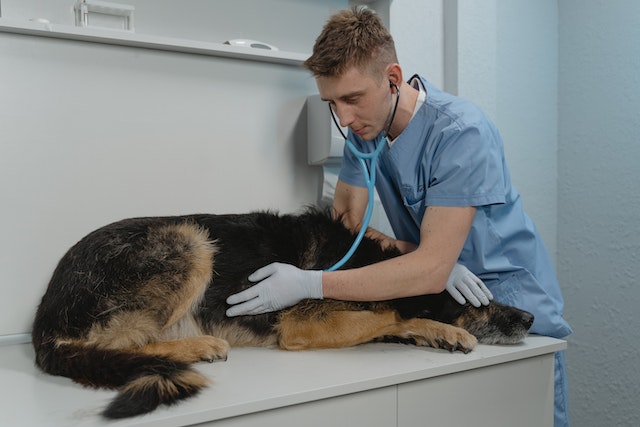
This article is contributed by guest author Shawn Richards (Content Writer at CritterTips).
5 Real Reasons Why Your Dog Is Shaking and What to Do About Them
Shaking in dogs can be a sign of many things; joy, excitement, fear, or any growing diseases inside their system.
Has your dog been showing signs of light to heavy shaking or shivering lately? Is your dog panting and shaking at the same time more often? Has your pup gone under the weather for a while, not eating or playing at all? Or is it just the cold outside that’s bothering your furry friend mostly?
You must identify these signs in your pooch and take necessary actions to avoid any possible harm from befalling them.
Read our article where you’ll learn five real reasons why your dog is shaking and what to do about them in the first place.
5 Real Reasons Behind Your Dog’s Shaking
The sign of shaking in pets is so subtle sometimes that you might not even clearly notice it. This applies to dogs as well as many other pets.
If you’re on your toes and busy throughout the day, it can be hard to look after your tail-wagging friend properly. This might be a reason that your dog’s been developing some complications inside them, be it due to their surroundings or something wrong the dog has eaten.
Signs like shaking, head pressing against your body, isolating from the crowd, pacing from one room to the other, circling its tail, etc., derive from such physical malfunctions.
Let’s find out the five reasons why a dog trembles and how to deal with them in the following:
1. Your Dog Might Be in Pain

One of the biggest reasons behind a dog’s shaking symptoms is pain. Sometimes you won’t notice any sign of external injury on your pooch’s body because it might be an internal issue.
As per many expert vets, dogs might be seen trembling due to arthritis.
Additionally, dogs may show signs of discomfort or tremor while trying to move. This might be a case of bone cancer that your dog has developed over time.
Signs of trembling often appear in dogs alongside panting, stiffness, lack of appetite, etc.
Don’t waste much time if you observe these symptoms in your furry companion. Call a vet immediately or take your pup to the nearest vet clinic for necessary treatment.
2. Your Dog May be Feeling Cold

One of the most obvious reasons on the list is the too-low temperature outside or inside the house. If the cold is making you shiver, it will undoubtedly happen to your dog as well. After all, they’re not cold-proof only because they’re fluffy and thick!
Some breeds are indeed more cold-tolerant than others, however, it’s not unnatural if your dog is getting chills in winter.
Most large house dogs can prevent their bodies from hypothermia in winter by pumping up their blood circulation. However, they too are sometimes seen to be shivering involuntarily.
If you have a small dog breed like a terrier, chihuahua, or pomeranian, chances are that your tiny buddy will be affected by the chilling temperature.
In this situation, the best practice is to keep them warm by wrapping a comfortable dog sweater around their body and letting your pup rest near a heating vent. However, you must make sure you don’t let your dog get too close to the fireplace! Accidents happen, and you don’t want a fire-related hazard to harm your furry friend!
3. Your Furry Friend Wants Your Attention

Dogs quickly learn what specific things they can do that will grab your attention. Most dog breeds shiver in excitement and joy when they see their family returning home or approaching to cuddle or play with them. The same thing happens when you’re about to treat them to their favorite snacks.
As they grow into these reactive expressions, you’ll likely find them doing those shaky and wiggly movements to seek your attention or sympathy. As soon as they see you, your furry little friend can slouch on the floor or just stare at you for some food or urge you to play with or pet them.
In this case, you can simply pet or play with your dog for a while so they’re content enough to get back to their regular mood. Additionally, you can feed your pup a treat, or let them rest beside you. Learning some tips to keep your dog happy while working from home is incredibly beneficial to keeping your pup pleased and feeling cared for during your workday.
4. Your Dog Is Getting Older
Your puppy won’t stay young and playful forever. It can be sad to watch your furry friend age, but the fear of chance or their future absence can’t stop you from caring for your old buddy now like you always did. Older dogs are prone to shaking. It’s very natural given their age, loss of circulation, and potential joint issues that accompany aging.
As your pup grows older, your dog will gradually lose its muscle mass and bone vitality; two very important things to keep its skeleton actively moving with agility. Hence, you’ll observe a tremoring effect on your dog’s body as it tries to walk from one corner of the room to the other or complete other physical activities.
Another reason for an older dog to shake is cold, as mentioned above. Due to losing the fat retention or muscle mass function, your pup might not be as resiliant to cold seasons as it used to be.
You can control this problem by keeping your dog warm and mostly inside (save for necessary bathroom breaks and exercise) to save your older pet from outdoor hazards. Moreover, take your senior pup to the vet to get a check-up if you suspect any disease underlies their symptoms.
5. Your Puppy Might’ve Been Poisoned

One of the most severe reasons behind your dog’s shaking could be poisoning. Shaking or trembling may not be the only sign of being poisoned in your dogs, but you may notice it in association with other symptoms like diarrhea, vomiting, drooling, seizures, etc.
Poisoning mostly occurs in dogs due to eating foods like chocolate, chewing gum, onions, avocado, a few types of nuts, xylitol or artificial sweetener, etc. Besides this, snail baits can prove to be fatal to dogs if eaten, inflicting symptoms like convulsion, muscle tremors, etc.
If you find your dog suffering from the symptoms mentioned above, call a vet or the local animal poison control professionals immediately to save your dog’s life. Earlier detection of the symptoms is more likely to save your pup’s life by suctioning the poison out of its system and getting your pup the nutrients/fluids they need to fight off the effects of poisoning.
Conclusion
You must be careful about identifying shaking signs in your dogs. As you’ve read above, worrisome trembling signs aren’t always easy to identify in dogs, and even if they are, they’re usually combined with other signs.
So, make sure you identify shaking in your pup in conjuntion with difficulty moving, sickness, and symptoms outlined in this article to accurately read what your pooch is going through. Moreover, keep your dog’s living space and food in check, so no external disease can easily enter its system. We love our furry friends, so making sure they are happy and healthy is an imperative part of being a good pet parent!

Lucienne
December 5, 2022 at 6:54 PMMy dog trembles when she waits for treats.
Cindy Tatum
January 2, 2023 at 6:27 PMMy latest rescue dog shaked terribly when I first got her. She had been a puppy mill dog. I figured it was fear. The rescue said it was MONTHS before her true personality revealed itself. We have had her 2 months and she doesn’t shake so much anymore. She occasionally does it when my tone changes when I find an accident in the house ( it’s always her).
Sharon
January 8, 2023 at 9:53 PMAll of a sudden my Zoeie started to shake uncontrollable when my grand daughter came into my room, it was so bad that I took her to the vet, she had no idea why Zoeie was shacking so bad, so 225.00 later no answer! My grand daughter has been in my bedroom hundreds of times, they played together all the time by the way my grand daughter is 18 years old! I have to close my bedroom door and hold Zoeie for the better part of an hour before she calms down! The thing is she doesn’t do it all the time! , my Zoeie is a mixed breed about 30 pounds. Thank you